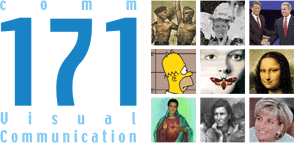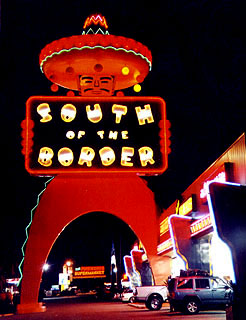
Office: HGH 210; phone: (408) 924-5378
Email: wooda@email.sjsu.edu
Web: http://www.sjsu.edu/faculty/wooda
 |
Dr. Andrew Wood Office: HGH 210; phone: (408) 924-5378 Email: wooda@email.sjsu.edu Web: http://www.sjsu.edu/faculty/wooda |
Reading:
Liebs, C.H. (1985). Main street to miracle mile: American roadside architecture. Baltimore: The Johns Hopkins University Press.
| Note: These comments are not designed to "summarize" the reading. Rather, they are available to highlight key ideas that will emerge in our classroom discussion. As always, it's best to read the original text to gain full value from the course. |
 Chester
H. Liebs helps us understand the impact of automobile transportation on urban
life by providing an historic and conceptual survey of downtown commercial architecture
in the twentieth century. In his chapter, "Architecture for Speed-Reading"
(pp. 39-73), Liebs discusses the tripartite form of main street storefronts
at the turn of the twentieth-century: sidewalk shop fronts, one to several stories
of flat wall, and some sort of cornice (typically ornamental). Liebs notes that
the Main Street storefront, whether in a small town or metropolitan city, confronted
the emergence of rapid forms of transportation which began with trolleys and
streetcars. The result was larger and more eye-catching advertisements designed
to attract eyeballs within a second or two. The impact of the automobile upon
architecture, however, was more pronounced away from Main Street, along the
newly laid roadways. Here, buildings did not simply display advertisements;
they became them.
Chester
H. Liebs helps us understand the impact of automobile transportation on urban
life by providing an historic and conceptual survey of downtown commercial architecture
in the twentieth century. In his chapter, "Architecture for Speed-Reading"
(pp. 39-73), Liebs discusses the tripartite form of main street storefronts
at the turn of the twentieth-century: sidewalk shop fronts, one to several stories
of flat wall, and some sort of cornice (typically ornamental). Liebs notes that
the Main Street storefront, whether in a small town or metropolitan city, confronted
the emergence of rapid forms of transportation which began with trolleys and
streetcars. The result was larger and more eye-catching advertisements designed
to attract eyeballs within a second or two. The impact of the automobile upon
architecture, however, was more pronounced away from Main Street, along the
newly laid roadways. Here, buildings did not simply display advertisements;
they became them.
 Hereafter,
Liebs concentrates on various types of imagery that dominated roadside architecture.
After World War One, the dominant style was domestic. Images of homes
and cabins - including picket fences and front window geraniums - appealed to
motorists, many of whom feared for their own domestic security during the Depression.
During the same period, "fantastic" design, the use of oversized objects, and
mimetic architecture - structures disguised as other objects - began
to compete with domestic architecture. Naturally, these structures had, for
centuries, been a part of the urban scene. However, buildings shaped like hot
dogs, windmills, and even elephants (image right) became more common in the
1920s. A third architectural style was regional/historic - buildings
that affirmed stereotypical and caricatured visions of "local" forms and referents.
Thus, "teepees" sprouted in the Southwest, while "colonial revival" buildings
appeared along the Atlantic.
Hereafter,
Liebs concentrates on various types of imagery that dominated roadside architecture.
After World War One, the dominant style was domestic. Images of homes
and cabins - including picket fences and front window geraniums - appealed to
motorists, many of whom feared for their own domestic security during the Depression.
During the same period, "fantastic" design, the use of oversized objects, and
mimetic architecture - structures disguised as other objects - began
to compete with domestic architecture. Naturally, these structures had, for
centuries, been a part of the urban scene. However, buildings shaped like hot
dogs, windmills, and even elephants (image right) became more common in the
1920s. A third architectural style was regional/historic - buildings
that affirmed stereotypical and caricatured visions of "local" forms and referents.
Thus, "teepees" sprouted in the Southwest, while "colonial revival" buildings
appeared along the Atlantic.
Thus far, these styles - domestic, mimetic, and regional/historic - share in common the desire to affirm traditional expectations through literal depictions of objects. Even the oversized, fantastic imagery of the mimetic elephant-hotel tried to relate its product to the natural world in some way. In contrast Moderne (roadside or otherwise) is most noted for its willingness to replace literal forms with abstract design. Moderne architecture is a combination of deco (noted by geometric flora and fauna), streamlined (noted by the teardrop motif), and International style (noted by flat roofs and corner windows). Moderne buildings abandoned traditional forms, selling promises of "the future" as sleek, clean, and efficient - thoroughly "new." As such, it was a perfect compliment to the automobile whose challenge to urban life was nothing less than revolutionary. Even so, after World War II, Moderne began to appear dated to architects and consumers. Thus, exaggerated modern (also known as googie, populuxe, and doo wop, and boomerang modern) emerged with huge plate glass windows, exposed structural components, and oversized roofs (think: 60s-era Denny's Restaurant).
As postwar-values shifted (and fears of environmental collapse intensified), Moderne roadside architecture quickly became viewed as tacky, ugly, and depressing. In its place (of, more frequently, tacked on top), overhanging slopped roofs, wood and earth tones, began to comprise an environmental style. As well, many architects rebelled against the anti-historic anti-regional architecture of the Moderne. Instead they began to playfully mix and match historical and regional references in a manner dubbed "postmodernism." Liebs concludes his chapter with a brief discussion of the "high tech" look that may yet enter the popular lexicon of architectural styles.
 |
 |
|
|
Domestic
|
Mimetic
|
|
 |
 |
|
|
Regional/historic
|
Moderne
|
Activity
Grab a camera and head downtown where you live. Photograph an example of commercial architecture that is either domestic, fantastic/mimetic, regional/historic, Moderne (note deco, streamlined, international, and/or exaggerated style), environmental, or postmodern style. In a one page essay, explain what style this building represents and identify at least three ways to support your analysis. Of course, remember: when analyzing roadside architecture, it's important to seek out designers and owners efforts to creatively blur otherwise distinct styles. If possible, seek examples in which buildings adapt themselves to changing times.
Supplemental Websites
San Jose Architecture <http://www.sjsu.edu/faculty/wooda/171/sanjose.html>- my growing collection of local styles that illustrate this reading.
To see examples of local Moderne architecture, I strongly recommend that you examine my South Bay Deco <http://www.sjsu.edu/faculty/wooda/southbaydeco/splash.html> website. You might also explore sub-pages dedicated to postcard images of: bus depots and auto courts.